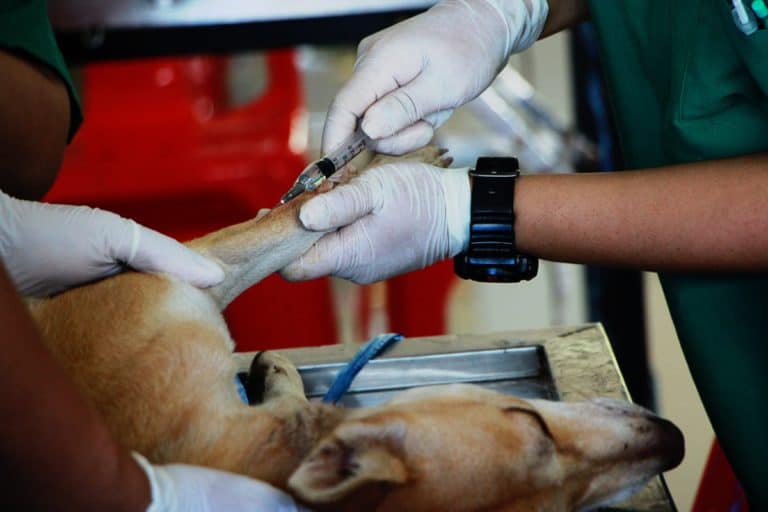(The article was reviewed by Dr Soren Drimer Pejstrup, DVM at dyrlægelisten.dk)
Our dogs are part of the family. They eat my leftovers and are my best friends. They come with me on my morning walk. The thing is, dogs really can’t complain so it’s not always easy to know when to look for medical help. How can you tell if their limping is an indication of a sprain or if their sneezing needs antibiotic treatments?
Like me, you may be wondering:
When should I call the vet for my dog?? How can you tell whether your dog requires urgent treatment? Is it a veterinary emergency this time or is he just depressed? How can you tell whether it is time to take your dog to the vet urgently?
There are veterinary emergencies you need to be aware of if you own a furry pal or two. This way, you will know when to take your dog to the vet immediately.
Most emergencies are obvious. Hemorrhagic diarrhoea, paralysis or collapse are urgent signs to take your best fur pal to the vet without a second thought. On the other hand, some urgently life-threatening problems such as bloating may not seem like a big deal at the onset.
When Should I Call The Vet For My Dog?
Take Your Dog To The Vet Even When He Has A Mild Condition
When it comes to asking yourself when should I call the vet for my dog, remember that situations don’t need to be life-threatening to warrant medical attention. Hot spots, bladder infections, ear infections or broken toenails are not emergencies. However, these are painful and treated best sooner rather than later if at all possible. When you feel unsure, what I suggest is to seek vet care. The reason I recommend this is that if your dog’s stomach aches, then no harm will come by going to the vet. However, if you ignore him and he is suffering from bloating, he may not make it by morning.
When Should I Call The Vet For My Dog?
Telephone Your Vet To Check!
Whether your vet works at a general practice or an emergency practice, they have phones. If you are wondering whether or not Fluffy needs urgent treatment, call your veterinarian describing what your dog is going through. Your vet can help you decide whether you need to bring him to urgent vet care immediately. Sometimes, your vet will advise you to monitor the health of your pet for a few hours before bringing him in.
When Should I Call The Vet For My Dog?
Check Your Dog’s Gums Before Taking Him To The Vet
Essentially, gums are indicative information regarding hemorrhage, shock, blood oxygenation and circulation. Normally, gums need to be most and pink when gently pressed with your finger. The portion you pressed needs to flash white then turn pink right away. Troubling signals are when gums are bright red, grey, blue or pale. It is best to regularly check your best fur pal’s gum on normal days. This way, you will know a distress signal the moment you check them again. When your dog is acting weak and you check his gums and they don’t look the way they normally do, then it is time to take your dog to the vet.
Here Is A List oF 13 Vet Emergencies
When should I take my dog to the emergency vet? Some huge emergencies require immediate vet care for your furry friend. The situations listed above are some of the most common situations of a dog emergency you or I could face. I must emphasize, however, that this list is not exhaustive. Personally, when I can’t tell if my pooches need emergency attention or not, it is always safer to take them to the vet. Here are a few critical and urgent emergencies as well as a few guidelines I have found very helpful in knowing what to do immediately when it comes to the health of your dogs.
1. Exposure To Toxic Substances
This immediately precipitates a visit to the vet. If you catch your dog munching on rat poison, it is not the time to wait around for seizures. Instead, take him to the vet as soon as you can. Other common exposures to substances poisonous to dogs include human medications, raisins, grapes, rodent bait or chocolate. He may even overdose on Rimadyl, a flavored medication for dogs.
2. Severe Pain
If your dog exhibits symptoms of agony or is limping profoundly, panting or vocalizing, don’t let him suffer. Go to the veterinarian immediately.
3. Loss Of Use Of Rear Legs
I saw this issue first hand, particularly with my Corgi and Dachshund. Other dogs that have long backs and short legs are called chondrodysplastic breeds. Losing the use of their legs in the rear can be a sign of spinal cord injury. This partial or total paralysis is quite painful. The outcome depends on how rapidly you can take your dog to the vet.
4. Coughing
When you hear your dog coughing, it could be as simple as kennel cough, which is harmless. On the other hand, it could be caused by exposure to rat bait or pneumonia. If the latter is the case, this is a vet emergency. The safest action is to go to the vet immediately. This is particularly true if you never heard your dog cough before.
5. Not Drinking Or Eating
When your dog isn’t drinking any water or eating any food, you will need to make a judgment call. I know when my furry bestie ignores his favorite food, there is something wrong indeed. Some dogs pass up a meal here or there intermittently. However, dogs that don’t eat longer than a day are usually sick. They usually won’t drink as much water as they should, either. Thus, watch for dehydration when your dog isn’t eating.
6. Urination Problems
When your dog is struggling to urinate, it may be an indication of a bladder infection. These cause them pain but are not life-threatening. However, this could also be a symptom of bladder stones obstructing their urinary tract, which s an urgent issue. Your pet needs to see the vet as soon as possible due to the pain of bladder infections and to check for stones.
7. Diarrhea Or Vomiting
Diarrhoea or vomiting or both is a vet emergency. This is particularly true if the liquid has blood. Dogs that have one instance of loose stools or vomit once may not require treatment if, after a few hours of resting, they are fine again. In contrast, repeated diarrhoea or vomiting leads to dehydration, which can be life-threatening. These are also symptoms of potentially bigger problems such as obstructions of the gastro-intestines.
8. Major Trauma or Profuse Hemorrhage
These are vet emergencies. Dogs that have been hit by a car, fallen from a height or had fought with larger dogs may seem unharmed but have internal injuries. Profuse haemorrhage means a lot of bleeding. Whether external or internal, all these occurrences mean that your dog needs to be brought to a vet immediately.
9. Profound Weakness Or Collapse
Internal bleeding can be a symptom of major health issues such as hemoabdomen. Cardiac comprise is the result of conditions that include the glandular condition of Addison’s disease, certain poisoning, anaphylactic shock, and pericardial effusion. These issues all require urgent vet care.
10. Seizures
Seizures may not be as life-threatening as other emergencies. However, progressive seizures start mildly and then develop into something potentially fatal. Seizures come in clusters and are caused by toxins.
11. Abdominal Distention
Volvulus with gastric dilation is also known as bloating. For dogs, bloat is one of the most urgently life-threatening situations of them all. Dogs might only act restless and pant while others exhibit all the symptoms of bloat. Dogs that suspiciously exhibit all the symptoms of bloat need to be brought to see the nearest vet as soon as possible.
12. Extreme Thirst
How much water does your dog normally drink each day? Knowing how much he or she drinks can help you monitor when something is wrong. When your dog seems excessively thirsty, this could be an indication of diabetes or kidney disease developing. You will be able to tell if your dog is drinking way too much water if you keep having to refill their bowl of water more than the usual. You will also know they have been overly thirsty if their urine seems excessive, have accidents in the house or need to go outside more frequently.
13. Not Breathing
The mother of all vet emergencies is when your dog has a hard time breathing, or can’t breathe at all. After three minutes of not being able to breathe, you may lose your dog. If your dog is breathing funny or having trouble, puffs his lips when he breathes or is making strange noises with every breath, he needs immediate vet care.
For your convenience, here is a quick list to check and see if your dog needs to be taken to the vet stat. You will need to seek medical attention immediately from your emergency vet clinic or your veterinarian if your pooch shows any of these symptoms:
- Swollen, hard abdomen
- Shaking
- Whining and displaying extreme pain
- Trying to vomit or retching without any food coming out
- One hour of vomiting blood or repeated vomiting
- When you saw them consuming something toxic
- Difficulty breathing or sudden collapse
- Seizures
- Unconsciousness
- They stopped breathing
- Pale gums
- Sudden disorientation
- Dragging of limbs
- Wobbliness
- Unable to standing
- Ability to deliver puppies
- Laboured breathing
- Inability to urinate
- Possible broken bones
- Open wounds
- A fall or other injury due to trauma or
- Getting hit by a vehicle even if he seems to be acting okay.
Find out from your veterinarian if the breed you have is prone to some of these. Clarify all the questions you might have. Keep in mind that knowing your dog’s habits will help you determine what is an emergency and what isn’t. Knowing his routine behavior is key. Trust your gut instinct and call the vet as soon as you have any concerns.
Frequently Asked Questions
My dog tries to vomit but nothing comes out?
When your dog tries to vomit but nothing comes out, this could be a symptom of bloat. It could also be an indication that your dog has eaten something he was not supposed to eat such as human medication, chocolate, raisins, a frog and so on. Take your dog to the vet as soon as you see him repeatedly trying to vomit but nothing comes out. This is definitely a vet emergency.
What if my dog has a discharge from her vulva?
Vaginal discharge is anything that comes out of your pet dog’s vagina. This could be pus, blood or mucus. Ther are so many causes of a vaginal discharge in dogs that it is best to take your dog to the vet. When your female dog is in heat, a discharge of blood will come from her vulva. If you see a discharge that isn’t blood, it could be hormonal or vaginitis which is caused by bacteria. See if your dog is having a hard time urinating, is licking her vulva, has a discharge of pus repeatedly or if male dogs are going after her even when she is not in heat. The culprit could be hormonal disorders or vaginitis. Make an appointment with your vet to rule out a vaginal infection from your dog.
Are dog seizures an emergency?
Yes, dog seizures are an emergency. This is particularly true if your dog has never had a seizure in the past. The seizures could be caused by an allergic reaction to something, having eaten something toxic or idiopathic epilepsy. Other causes include brain trauma, tumours or kidney failure. Take your dog to the vet to rule out any of the above disorders.
Is dog conjunctivitis an emergency?
Conjunctivitis in dogs is not an infection and in and of itself is not a serious condition. However, it won’t clear up without getting treated. Even if conjunctivitis in dogs is not urgent the way a broken bone is, it is still an issue that needs to be addressed. Plus, without treatment, your dog’s conjunctivitis could develop into vision loss or a permanent eye injury. Thus, it is best to treat conjunctivitis in dogs.
Collapse: How long does shock last in a dog?
Dog shock can last between thirty minutes or days. To stabilize a dog in shock, it will need medical treatment and will not get better on its own. Generally, it is better to seek immediate help as shock can rapidly worsen and even kill your dog. The reason is that hypovolemic shock affects the respiratory, gastrointestinal and cardiovascular systems of a dog.
How do I tell that my dog is in pain?
You can tell that your dog is in pain if they growl, yelp, cry out or hide. They are less active and become grumpy or resent normal handling. They can even snap at you or are sensitive when you touch them. Take your dog to the vet immediately when your pooch exhibits signs of pain.
This article was first published at dyrlægelisten.dk





